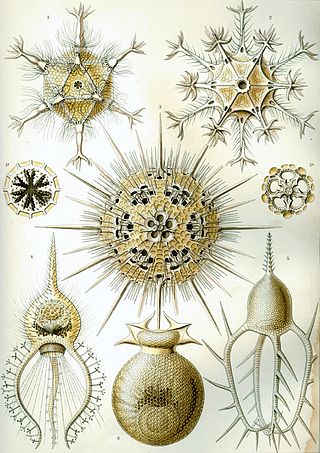
The Noctilucales are an order of marine dinoflagellates. They differ from most others in that the mature cell is diploid and its nucleus does not show a dinokaryotic organization. They show gametic meiosis.

Phaeodarea or Phaeodaria is a group of amoeboid cercozoan organisms. They are traditionally considered radiolarians, but in molecular trees do not appear to be close relatives of the other groups, and are instead placed among the Cercozoa. They are distinguished by the structure of their central capsule and by the presence of a phaeodium, an aggregate of waste particles within the cell.
The Ascetosporea are a group of eukaryotes that are parasites of animals, especially marine invertebrates. The two groups, the haplosporids and paramyxids, are not particularly similar morphologically, but consistently group together on molecular trees, which place them near the base of the Cercozoa. Both produce spores without the complex structures found in similar groups.

Chatton is a village in Northumberland, in England. It is roughly 6 km (3.7 mi) to the east of Wooler.
The Syndiniales are an order of early branching dinoflagellates, found as parasites of crustaceans, fish, algae, cnidarians, and protists. The trophic form is often multinucleate, and ultimately divides to form motile spores, which have two flagella in typical dinoflagellate arrangement. They lack a theca and chloroplasts, and unlike all other orders, the nucleus is never a dinokaryon. A well-studied example is Amoebophrya, which is a parasite of other dinoflagellates and may play a part in ending red tides. Several MALV groups have been assigned to Syndiniales; recent studies, however, show paraphyly of MALVs suggesting that only those groups that branch as sister to dinokaryotes belong to Syndiniales.
Flaming Youth were a British rock band, active in the late 1960s. They were not commercially successful and are now remembered primarily as Phil Collins' first band that had a recording deal.
Yo Amo a Juan Querendón is a Mexican telenovela produced by Mapat L. de Zatarain for Televisa in 2007. The telenovela was a remake of Pedro El Escamoso, a Colombian telenovela.

Édouard Chatton was a French biologist who first characterized the distinction between the prokaryotic and eukaryotic cellular types.
James Harry Chatton, was an Irish footballer who played for several clubs in the Scottish League, the American Soccer League and the League of Ireland. Chatton was a dual internationalist and played for both Ireland teams – the IFA XI and the FAI XI.

Cyclic AMP-dependent transcription factor ATF-7 is a protein that in humans is encoded by the ATF7 gene.

Dinophyceae is a class of dinoflagellates.
Chatton is an unincorporated community in Houston Township, Adams County, Illinois, United States. Chatton is north of Golden.
The Chatton transmitting station is a broadcasting and telecommunications facility, between Wooler and Seahouses, Northumberland. It is owned and operated by Arqiva, and situated within the boundary of Bewick and Beanley Moors SSSI.

Leptomonas is a genus of parasitic flagellate protist belonging to family Trypanosomatidae and subfamily Leishmaniinae sensu Maslov & Lukeš 2012. It is a monoxenous parasite of mainly Hemiptera, Diptera, and Siphonaptera insects.
Kofoidinium is a genus of dinoflagellates belonging to the family Kofoidiniaceae. It only contains one known species,

Gymnodiniaceae is a family of dinoflagellates belonging to the order Gymnodiniales.

Blastodiniales is an order of dinoflagellates belonging to the class Dinophyceae.








